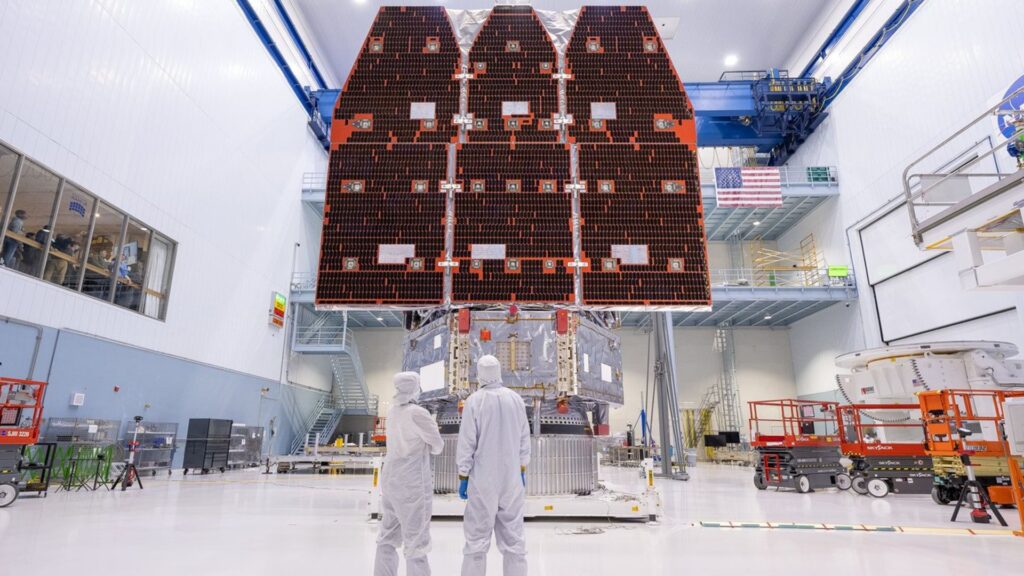Now Reading: Mars orbiter spies ‘barcode’ aftermath of rare Red Planet avalanche caused by meteoroid impact
-
01
Mars orbiter spies ‘barcode’ aftermath of rare Red Planet avalanche caused by meteoroid impact
Mars orbiter spies ‘barcode’ aftermath of rare Red Planet avalanche caused by meteoroid impact


On Christmas Eve in 2023, a European Space Agency (ESA) spacecraft captured what looks like a barcode etched into the rusty slopes of Mars.
The image, taken by ESA’s ExoMars Trace Gas Orbiter, shows dark, finger-like trails streaking down the flanks of Apollinaris Mons, a vast extinct volcano near the Martian equator. Each stripe — some just a few yards wide, others hundreds across — traces the path of a dust avalanche, triggered when a meteoroid struck the surface, shaking loose fine grains that cascaded downslope, according to a ESA statement.
A new study led by Valentin Bickel of the University of Bern in Switzerland finds that fewer than one in a thousand slope streaks form after meteoroid impacts like the one near Apollinaris Mons. Instead, most are sparked by seasonal changes in wind and dust activity, the study reports.
“Meteoroid impacts and quakes seem to be locally distinct, yet globally relatively insignificant drivers,” Bickel said in the ESA statement.
To reach that conclusion, the researcher analyzed more than 2 million slope streaks across 90,000 orbital images of Mars taken between 2006 and 2024 — most from NASA’s Mars Reconnaissance Orbiter (MRO). Building on earlier work that cataloged 86,000 streaks, Bickel cross-referenced their new database with global maps of temperature, wind speed, surface hydration, landslides and dust-devil activity.
Using an improved deep-learning algorithm, the researcher scanned the full archive of images taken by MRO’s Context Camera, or CTX, which is designed to monitor changes across the Martian surface. This approach let him pinpoint when and where streaks formed — revealing global patterns of seasonality of slope streak formation across Mars — and estimate how much dust these processes inject into Mars’ atmosphere.
The findings show that most of the streaks appear in step with the planet’s dustiest seasons, especially during the southern summer and autumn, when winds exceed the threshold needed to set sand-sized particles in motion.
By estimating how much dust slope streaks move in total and comparing that with existing data on Mars’ global dust circulation, Bickel found that these small streaks together lift about a quarter of all the dust exchanged between the surface and atmosphere each year, roughly the same amount stirred up by two planet-wide dust storms.
“The conditions most conducive to seasonal streak formation appear to occur at sunrise and sunset,” Bickel wrote in the new paper. Because Mars orbiters rarely capture images at these dimmer hours, such events have yet to be seen unfolding in real time, he added.
The study also highlights five global “hotspots” for slope streaks — Amazonis, the Olympus Mons aureole, Tharsis, Arabia, and Elysium — all major geographical features on Mars where steep slopes, loose dust, and just-strong-enough winds combine to set the surface in motion.
“These observations could lead to a better understanding of what happens on Mars today,” Colin Wilson, the project scientist for the ExoMars Trace Gas Orbiter, said in the statement.
The findings, detailed in a paper published Nov. 6 in the journal Nature Communications.
Stay Informed With the Latest & Most Important News
Previous Post
Next Post
-
 012024 in Review: Highlights from NASA in Silicon Valley
012024 in Review: Highlights from NASA in Silicon Valley -
 02Panasonic Leica Summilux DG 15mm f/1.7 ASPH review
02Panasonic Leica Summilux DG 15mm f/1.7 ASPH review -
 03How New NASA, India Earth Satellite NISAR Will See Earth
03How New NASA, India Earth Satellite NISAR Will See Earth -
 04And Thus Begins A New Year For Life On Earth
04And Thus Begins A New Year For Life On Earth -
 05Astronomy Activation Ambassadors: A New Era
05Astronomy Activation Ambassadors: A New Era -
06SpaceX launch surge helps set new global launch record in 2024
-
 07From Polymerization-Enabled Folding and Assembly to Chemical Evolution: Key Processes for Emergence of Functional Polymers in the Origin of Life
07From Polymerization-Enabled Folding and Assembly to Chemical Evolution: Key Processes for Emergence of Functional Polymers in the Origin of Life




















